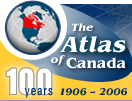| This map shows the distribution of the 41
000 persons identifying themselves as Inuit in the 1996 Census.
The Inuit population is illustrated by means of point symbols that
increase in size with the size of the population. The symbols are
located at the centre of the 276 census subdivisions (CSDs)
containing a population of 15 or more Inuit.
The Inuit population is almost entirely situated north of the 50th
parallel. The great majority (84%) of the population of Nunavut
is Inuit, this being one of the reasons why land claims led to the
creation of the territory of Nunavut in 1999. Sixty-two per cent
of the Inuit live in Nunavut and in the Northwest Territories, 21%
in northern Quebec and 10% in Labrador.
The communities of Nunavut are composed of a fairly homogenous
Inuit population. Canada contains 15 communities of more than 1000 Inuit. The names of these communities can be displayed by zooming
to 1:15 000 000 scale: eleven are located in Nunavut, three in northern
Quebec and one is in Labrador.
Zooming to 1:7 500 000 scale displays the toponyms of communities
with more than 300 Inuit. These 39 communities all have a majority
Inuit population, with the exception of Happy Valley-Goose Bay in
Labrador and Yellowknife in the Northwest Territories.
Finally, at scale 1:2 000 000, the toponyms of the 52 communities
of over 120 Inuit are displayed on the map. Less than 10% of Inuit
live in cities in southern Canada. |
